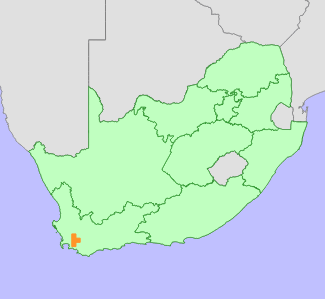|
Scientific Name | Trieenea longipedicellata Hilliard |
Higher Classification | Dicotyledons |
Family | SCROPHULARIACEAE |
National Status |
Status and Criteria | Rare |
Assessment Date | 2018/05/10 |
Assessor(s) | L. von Staden |
Justification | Trieenea longipedicellata has an extent of occurrence (EOO) of 387 km². It is a rare and localized habitat specialist, known from six subpopulations. It has no severe threats and is not suspected to be in danger of extinction. It is therefore listed under the IUCN 3.1 Criteria, globally, as Least Concern but is nationally categorised as Rare. |
Distribution |
Endemism | South African endemic |
Provincial distribution | Western Cape |
Range | This species is endemic to South Africa, and is found in the mountains between Paarl, Stellenbosch and Villiersdorp. |
Habitat and Ecology |
Major system | Terrestrial |
Major habitats | Kogelberg Sandstone Fynbos, Hawequas Sandstone Fynbos |
Description | It occurs in damp places under sandstone overhangs, 1500-1980 m. |
Threats |
| There are no threats to Trieenea longipedicellata. |
Population |
It is a very localized habitat specialist, that is rarely collected. It occurs on high mountain peaks where it is facing no severe threats, and therefore the population is not suspected to be declining.
|
Population trend | Stable |
Assessment History |
Taxon assessed |
Status and Criteria |
Citation/Red List version | | Trieenea longipedicellata Hilliard | Rare | Raimondo et al. (2009) | |
Bibliography |
Goldblatt, P. and Manning, J.C. 2000. Cape Plants: A conspectus of the Cape Flora of South Africa. Strelitzia 9. National Botanical Institute, Cape Town.
Hilliard, O.M. 1994. The Manuleae: a tribe of Scrophulariaceae. Edinburgh University Press, Edinburgh.
Raimondo, D., von Staden, L., Foden, W., Victor, J.E., Helme, N.A., Turner, R.C., Kamundi, D.A. and Manyama, P.A. 2009. Red List of South African Plants. Strelitzia 25. South African National Biodiversity Institute, Pretoria.
|
Citation |
| von Staden, L. 2018. Trieenea longipedicellata Hilliard. National Assessment: Red List of South African Plants version 2024.1. Accessed on 2025/12/04 |
 Comment on this assessment
Comment on this assessment


